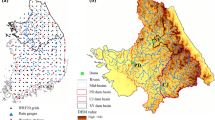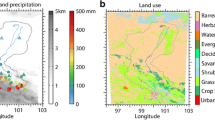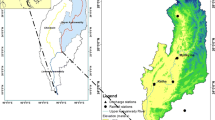Abstract
The goal of this study was to evaluate the ability of dynamically downscaled reanalysis data to reproduce local-scale spatiotemporal precipitation and temperature data needed to accurately predict streamflow in the Tampa Bay region of west central Florida. In particular, the Florida State University Center for Ocean-Atmospheric Prediction Studies CLARReS10 data (NCEP DOE 2 reanalysis data (R2) downscaled to 10-km over the Southeast USA using the Regional Spectral Model (RSM) were evaluated against locally available observed precipitation and temperature data and then used to drive an integrated hydrologic model that was previously calibrated for the Tampa Bay region. Resulting streamflow simulations were evaluated against observed data and previously calibrated model results. Results showed that the raw downscaled reanalysis predictions accurately reproduced the seasonal trends of mean daily minimum temperature, maximum temperature and precipitation, but generally overestimated the monthly mean and standard deviation of daily precipitation. Biases in the temporal mean and standard deviation of daily precipitation and temperature predictions were effectively removed using a CDF-mapping approach; however, errors in monthly precipitation totals remained after bias correction. Monthly streamflow simulation error statistics indicated that the accuracy of the streamflow produced by the bias-corrected downscaled reanalysis data was satisfactory (i.e., sufficient for seasonal to decadal planning), but that the accuracy of the streamflow produced by the raw downscaled reanalysis data was unsatisfactory for water resource planning purposes. The findings of this study thus indicate that further improvement in large-scale reanalysis data and regional climate models is needed before dynamically downscaled reanalysis data can be used directly (i.e. without bias correction with local data) to drive hydrologic models. However, bias-corrected dynamically downscaled data show promise for extending local historic climate observation records for hydrologic simulations. Furthermore, results of this study indicate that similarly bias-corrected dynamically downscaled retrospective and future GCM projections should be suitable for assessing potential hydrologic impacts of future climate change in the Tampa Bay region.





Similar content being viewed by others
References
Beck A, Ahrens B, Stadlbacher K (2004) Impact of nesting strategies in dynamical downscaling of reanalysis data. Geophys Res Lett 31:L19101
Bicknell B, Imhoff JC, Kittle JL, Jobes TH, Donigian AD (2001) Hydrologic simulation program-FORTRAN (HSPF): user’s manual for version 12. U.S Environmental Protection Agency, Athens, GA
Bromwich DH, Fogt RL (2004) Strong trend in the skill of the ERA-40 and NCEP-NCAR reanalyses in the high and midlatitudes of the southern hemisphere, 1958–2001. J Clim 17:4603–4619
El-Sadek A, Bleiweiss M, Shukla M, Guldan S, Fernald A (2011) Alternative climate data sources for distributed hydrological modeling on a daily time step. Hydrol Process 25:1542–1557
Fowler HJ, Blenkinsop S, Tebaldi C (2007) Linking climate change modeling to impacts studies: recent advances in downscaling techniques for hydrological modeling. Int J Climatol 27:1547–1578
Geurink J, Basso R (2012) Development, calibration, and evaluation of the Integrated Northern Tampa Bay Hydrologic Model. Tampa Bay Water and the Southwest Florida Water Management District, Clearwater, FL
Geurink J, Basso R, Tara P, Trout K, Ross M (2006) Improvements to integrated hydrologic modeling in the Tampa Bay, Florida region: hydrologic similarity and calibration metrics. In: Proceedings of the joint federal interagency conference 2006, Reno, NV
Giorgi F, Hewitson B, Christensen J, Hulme M, Von Storch H, Whetton P, Jones R, Mearns L, Fu C (2001) Regional climate information -evaluation and projections. In: Climate change 2001: the scientific basis. Cambridge University Press, Cambridge, pp 583–638, 739–768
Haberlandt U, Kite GW (1998) Estimation of daily space-time precipitation series for macroscale hydrological modeling. Hydrol Process 12:1419–1432
Harbaugh AW, McDonald MG (1996) Programmer’s documentation for MODFLOW-96, an update to the U.S. Geological Surbay modular finite-difference ground-water flow model, U.S. Geological Survey Open-File Report 96-486, Reston, VA
Hargreaves GH, Samani ZA (1985) Reference crop evapotranspiration from temperature. Appl Eng Agric 1:96–99
Hay LE, Clark MP (2003) Use of statistically and dynamically downscaled atmospheric model output for hydrologic simulations in three mountainous basins in the western United States. J Hydrol 282:56–75
Hwang S, Graham W, Hernández JL, Martinez C, Jones JW, Adams A (2011) Quantitative spatiotemporal evaluation of dynamically downscaled MM5 precipitation predictions over the Tampa Bay region, Florida. J Hydrometeorol 12(6):1447–1464
Iizumi T, Nishimori M, Dairaku K, Adachi AS, Yokozawa M (2011) Evaluation and intercomparison of downscaled daily precipitation indices over Japan in present-day climate: strengths and weaknesses of dynamical and bias correction-type statistical downscaling methods. J Geophys Res 116:D01111
Jasper K, Gurtz J, Lang H (2002) Advanced flood forecasting in Alpine watersheds by coupling meteorological observations and forecasts with a distributed hydrological model. J Hydrol 267:40–52
Jonathan TO, Meehl GA, Bony S, Easterling DR (2011) Climate data challenges in the 21st century. Science 331:700. doi:10.1126/science.1197869
Juang HMH, Kanamitsu M (1994) The NMC nested regional spectral model. Mon Weather Rev 122:3–26
Kanamitsu M, Kanamaru H (2007) Fifty-seven year California reanalysis downscaling at 10 km (CaRD10). Part I: system detail and validation with observations. J Clim 20:5553–5571
Kanamitsu M, Evisuzaki W, Woollen J, Yang S-K, Hnilo JJ, Fiorino M, Potter GL (2002) NCEP/DOE AMIP-II Reanalysis (R-2). Bull Am Meteorol Soc 83:1631–1643
Lim Y-K, Stefanova LB, Chan SC, Schubert SD, O’Brien JJ (2011) High-resolution subtropical summer precipitation derived from dynamical downscaling of the NCEP/DOE reanalysis: how much small-scale information is added by a regional model? Clim Dyn 37:1061–1080. doi:10.1007/s00382-010-0891-2
Lo JC, Yang Z, Pielke RA Sr (2008) Assessment of three dynamical climate downscaling methods using the Weather Research and Forecasting (WRF) model. J Geophys Res 113:D09112. doi:10.1029/2007JD009216
Mearns LO, Giorgi F, Whetton P, Pabon D, Hulme M, Lal M (2003) Guidelines for use of climate scenarios developed from regional climate model experiments. Data distribution centre of the Intergovernmental. Panel Clim Change. http://www.ipcc-data.org/guidelines/dgm_no1_v1_10-2003.pdf
Mesinger F, Janjić ZI, Nicković S, Gavrilov D, Deaven DG (1988) The step-mountain coordinate: model description and performance for cases of Alpine lee cyclogenesis and for a case of an Appalachian redevelopment. Mon Weather Rev 116:1493–1518
Mesinger F, DiMego G, Kalnay E, Shafran P, Ebisuzaki W, Jovic D, Woollen J, Mitchell K, Rogers E, Ek M, Fan Y, Grumbine R, Higgins W, Li H, Lin Y, Manikin G, Parrish D, Shi D (2006) North American regional reanalysis. Bull Am Meteorol Soc 87:343–360
Moriasi DN, Arnold JG, Van Liew MW, Bingner RL, Harmel RD, Veith TL (2007) Model evaluation guidelines for systematic quantification of accuracy in watershed simulation. Trans ASABE 50(3):885–900
Nash JE, Sutcliffe JV (1970) River flow forecasting through conceptual models part I: a discussion of principles. J Hydrol 10:282–290. doi:10.1016/0022-1694(70)90255-6
Panofsky HA, Brier GW (1968) Some applications of statistics to meteorology. The Pennsylvania State University, University park, p 224
Piani C, Weedon GP, Best M, Gomes SM, Viterbo P, Hagemann S, Haerter JO (2010) Statistical bias correction of global simulated daily precipitation and temperature for the application of hydrological models. J Hydrol 395:199–215
Ross M, Trout K, Tara P, Said A, Geurink J (2004) A new discretization scheme for integrated surface and groundwater modeling. Hydrological science and technology. J Am Inst Hydrol (AIH) 21:143–156
Ross M, Geurink J, Said A, Aly A, Tara P (2005) Evapotranspiration conceptualization in the HSPF-MODFLOW integrated models. J Am Water Res Assoc 41(5):1012–1025
Stefanova L, Misra V, Chan S, Griffin M, O’Brien JJ, Smith JT III (2011) A proxy for high-resolution regional reanalysis for the southeast United States: assessment of precipitation variability in dynamically downscaled reanalyses. Clim Dyn 38(11):2449–2466. doi:10.1007/s00382-011-1230-y
Themeßl JM, Gobiet A, Heinrich G (2012) Empirical-statistical downscaling and error correction of regional climate models and its impact on the climate change signal. Clim Change 112:449–468
Uppala SM et al (2005) The ERA-40 re-analysis. Q J R Meteorol Soc 131:2961–3012
Wilby RL, Wigley TML (1997) Downscaling general circulation model output: a review of methods and limitations. Prog Phys Geogr 21:530–548
Wood AW, Leung LR, Sridhar V, Lettenmaier DP (2004) Hydrologic implications of dynamical and statistical approaches to downscaling climate model outputs. Clim Change 62:189–216
Author information
Authors and Affiliations
Corresponding author
Electronic supplementary material
Below is the link to the electronic supplementary material.
Rights and permissions
About this article
Cite this article
Hwang, S., Graham, W.D., Adams, A. et al. Assessment of the utility of dynamically-downscaled regional reanalysis data to predict streamflow in west central Florida using an integrated hydrologic model. Reg Environ Change 13 (Suppl 1), 69–80 (2013). https://doi.org/10.1007/s10113-013-0406-x
Received:
Accepted:
Published:
Issue Date:
DOI: https://doi.org/10.1007/s10113-013-0406-x




